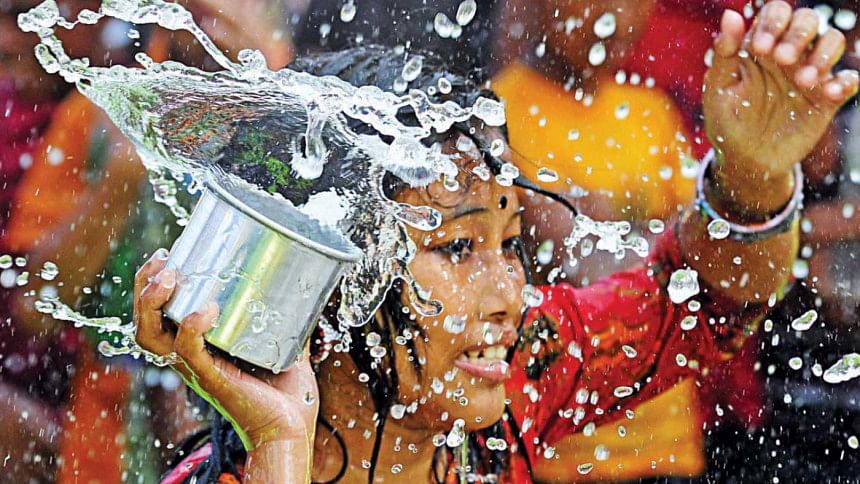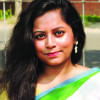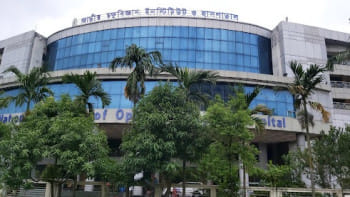Bangladesh: A potpourri of exquisite cultures

Bring on the platters of panta bhat and ilish. It's Pahela Baishakh -- the most colourful time of the year!
In the midst of the probhat pheri, melas, nationwide celebrations and momentary oblivion of our day to day worries, people all around the country set aside their differences to observe the first day of the Bangali calendar with gusto and joy. On this day, the fervent national spirit transcends beyond ethnicity, language, class and religion.
As we fulfill our gastronomical urges in the company of family and friends, laugh and sing in unison, and walk side by side in fairs and processions amidst a vibrant sea of colourful attire, we see Bangladesh for what it really is -- a country of 160 million with an immensely rich and diverse cultural heritage.
Bangladesh, a nation that boasts 45 ethnic minorities, is often viewed as a country of ethnic homogeneity, over 98 percent of its population being Bangali. The rest of the 2%, however, is comprised of various ethnic minorities with their own distinct traditions and rituals whose multilayered cultural characteristics give Bangladesh its very own pluralistic identity.
But, what do we really know about their new year celebrations?
CELEBRATIONS IN THE CHT
In the Chittagong Hill Tracts (CHT), indigenous tribes start off their new year with exciting festivals and fairs. For the Chakma people, the largest ethnic minority in the country, the New Year festivities are considered to be extremely, if not the most, important. Their New Year festival, known as Bizu, lasts three days of which the second day is observed as the 'main' day. The first day is dedicated to phul bijhu, the second to mul bijhu, and the last for gojyai pojya. Overall, the celebrations last up to a week. They begin the day by bathing early in the morning, and youngsters seek blessings by helping the elderly bathe. Flowers are offered to water bodies as a sign of respect and acknowledgment of their necessity in people's daily lives. The dish known as pajon ton, made up of at least seven types of vegetables, is made especially for this occasion. Young girls wear bright hand-woven blue and red lungis, and people of all ages go from house to house socialising at leisure.
The Marma, the second largest ethnic minority in the CHT, mainly live in the hill districts of Banderban, Khagrachari and Rangamati. For these predominantly Buddhist peoples, their new year festival called the Songkrai lasts for up to four days, the first three days of which are spent bidding farewell to the outgoing year while the fourth is spent greeting the incoming year. On the first day of the four-day festival, men and women form processions to carry images of Buddha down to the waterfront. There, the images are then washed with either a concoction of sandalwood and water, or milk and water; these images are prepared this way to be put up in temples or shrines at people's homes. On the last two days of the festivities, a fun celebration called pani khela takes place during which people splash water at each other, symbolically washing their sins of the previous year away and starting the coming year anew.
Then there's the Tripuri people, the original inhabitants of the Kingdom of Tripura in North East India and Bangladesh, who are spread all over Bangladesh -- as far as the CHT, Comilla, Noakhali and Sylhet. This ethnic group, whose roots in Bengal can be traced back as far as 2000 years ago, is predominantly Hindu, although there's a significant population of Christians and animists as well. The Tripuri people possess a rich historic cultural heritage which is reflected in their distinctive dance, music, clothes, festivals and gastronomy. Their new year known as the Baishu festival is observed for a continuous three days and is the biggest of all festivals. Flowers play a central role as houses and cattle are adorned with flowers, and both children and adults exchange and distribute flowers. The women make cakes with binni rice and cholai wine, as the men take part in competitive games of handicraft-making using bamboo and cane. Anywhere between 10 to 100 participants do the traditional goraia dance which depicts their primary basis of livelihood that is jhum (slash and burn) cultivation in the hills of Chittagong. The goraia dance lasts from seven to twenty-eight days, at the end of which the Goria Puja celebrations commence. Prayers are offered to the god Goria for a happy harvest once the sowing of seeds in the plot of land selected for jhum is over in mid-April.
Throughout the region of the CHT, wherein lies the largest concentration of indigenous peoples in Bangladesh, celebrations of the new year not only symbolise the beginning of a joyous and prosperous year ahead but also mark the robustness of the cultural bonds existing within these communities.
MULTICULTURAL OR MELTING POT?
While we use the terms 'multicultural' and 'melting pot' interchangeably, they are not quite the same. Whereas 'multicultural' refers to the institutionalisation of authentic cultural diversity through settlement policies implemented by the state, 'melting pot' refers to the assimilation of minorities to the dominant culture, in this case, to the Bangali culture. Multiculturalism allows for distinct cultures to retain their character (something like the American 'salad bowl' theory which states that American cultures are juxtaposed as opposed to assimilated); but a melting pot, on the other hand, is used to describe the transformation of a heterogeneous culture into a homogeneous one.
Although the indigenous peoples in Bangladesh have retained much of their cultural identity, they have simultaneously adopted many cultural elements of Bangalis through the passage of time. A significant number of Chakmas and Marmas, for example, speak Bangla fluently and even use 'Salam' as a greeting. Due to their large-scale migration to urban areas, the process of assimilation into the Bangali culture was expedited. Whether or not the cultural make-up of Bangladesh spells 'multicultural' or 'melting pot' remains a matter of debate. What's evident, however, is that, despite all odds, ethnic minorities and distinct cultural identities continue to thrive in Bangladesh where the indigenous peoples number anywhere between 1.7 to 3.7 million.
It's not just the younger generations that are oblivious of the rich and diverse cultural heritage that Bangladesh boasts. Most people probably have never even heard of ethnic groups like Banais, Bhuiya, Bhumijie, Kharia, Kharwar and Oraon.
Instead of always focusing on the dominant culture and its associated celebrations on this non-religious festival, we should all be aware of the beauty of diversity that these exquisite indigenous cultures bring. This consciousness will make us see these cultures for their richness and importance in creating our Bangladeshi identity.
The writer is a Journalist at The Daily Star.

 For all latest news, follow The Daily Star's Google News channel.
For all latest news, follow The Daily Star's Google News channel. 



Comments